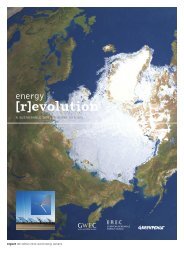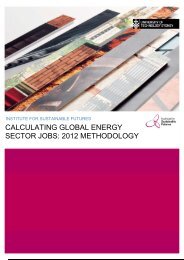download the mexico energy revolution scenario
download the mexico energy revolution scenario
download the mexico energy revolution scenario
Create successful ePaper yourself
Turn your PDF publications into a flip-book with our unique Google optimized e-Paper software.
figure 2.1: ftsm scheme<br />
developing country:<br />
Legislation:<br />
• feed-in law<br />
• guaranteed grid access<br />
• licensing<br />
FTSM<br />
roles and responsibilities<br />
(inter-) national finance institute(s)<br />
Organizing and Monitoring:<br />
• organize financial flow<br />
• monitoring<br />
• providing soft loans<br />
• guarantee <strong>the</strong> payment of <strong>the</strong> feed-in tariff<br />
image A WOMAN STUDIES SOLAR POWER SYSTEMS AT<br />
THE BAREFOOT COLLEGE. THE COLLEGE SPECIALISES<br />
IN SUSTAINABLE DEVELOPMENT AND PROVIDES A<br />
SPACE WHERE STUDENTS FROM ALL OVER THE WORLD<br />
CAN LEARN TO UTILISE RENEWABLE ENERGY. THE<br />
STUDENTS TAKE THEIR NEW SKILLS HOME AND GIVE<br />
THEIR VILLAGES CLEAN ENERGY.<br />
OECD country<br />
Legislation:<br />
• CO2 credits under CDM<br />
• tax from Cap & Trade<br />
• auctioning CO2 Certificates<br />
© GP/EMMA STONER<br />
2<br />
implementing <strong>the</strong> <strong>energy</strong> [r]evolution | FTSM SCHEME<br />
financing <strong>the</strong> <strong>energy</strong> [r]evolution with FTSM<br />
Based on both Energy [R]evolution Scenarios for developing (non-<br />
OECD) countries, a calculation has been done to estimate <strong>the</strong> costs<br />
and benefits of an FTSM programme using <strong>the</strong> following assumptions:<br />
power generation costs The average level of feed-in tariffs, excluding<br />
solar, has been calculated on <strong>the</strong> assumption that <strong>the</strong> majority of<br />
renewable <strong>energy</strong> sources require support payments of between 7 and<br />
15 cents per kilowatt-hour. While wind and bio <strong>energy</strong> power generation<br />
can operate on tariffs of below 10 cents per kWh, o<strong>the</strong>r technologies,<br />
such as geo<strong>the</strong>rmal and concentrated solar power, will need slightly<br />
more. Exact tariffs should be calculated on <strong>the</strong> basis of specific market<br />
prices within each country. The feed-in tariff for solar photovoltaic<br />
projects reflects current market price projections. The average<br />
conventional power generation costs are based on new coal and gas<br />
power plants without direct or indirect subsidies.<br />
specific CO2 reduction per kWh The assumed CO2 reduction per<br />
kWh from switching to renewables is crucial for calculating <strong>the</strong><br />
specific cost per tonne of CO2 saved. In non-OECD countries <strong>the</strong><br />
current level of CO2 emissions for power generation averages<br />
871 gCO2/kWh, and will reduce to 857 gCO2/kWh by 2030 (see<br />
Reference <strong>scenario</strong> Chapter 6). The average level of CO2 emissions<br />
over <strong>the</strong> period from 2010 to 2020 is <strong>the</strong>refore 864 gCO2/kWh.<br />
table 2.1: assumptions for ftsm calculations<br />
KEY<br />
PARAMETER<br />
2010<br />
2020<br />
2030<br />
AVERAGE<br />
FEED-IN<br />
TARIFF EXCL.<br />
SOLAR PV<br />
(ct/kWh)<br />
12<br />
11<br />
10<br />
AVERAGE<br />
FEED-IN<br />
TARIFF FOR<br />
SOLAR PV<br />
(ct/kWh)<br />
20<br />
15<br />
10<br />
financial parameters From <strong>the</strong> beginning of <strong>the</strong> financial crisis in<br />
mid-2008 it became clear that inflation rates and capital costs were<br />
likely to change very fast. The cost calculations in this programme<br />
do not take into account changes in interest rates, capital costs or<br />
inflation; all cost parameters are nominal based on 2009 levels.<br />
key results The FTSM programme would cover 624 TWh by<br />
2015 and 4,960 TWh by 2030 of new renewable electricity<br />
generation and save 77.6 GtCO2 between 2010 and 2030. This<br />
works out at 3.8 GtCO2 per year under <strong>the</strong> basic Energy<br />
[R]evolution <strong>scenario</strong> and 82 GtCO2 or 4.1 GtCO2 per year under<br />
<strong>the</strong> advanced version. With an average CO2 price of $23.1 per<br />
tonne, <strong>the</strong> total programme would cost $1.62 trillion. This works<br />
out at $76.3 billion annually under <strong>the</strong> basic version and $1.29<br />
trillion or $61.4 billion annually under <strong>the</strong> advanced <strong>scenario</strong>.<br />
Under <strong>the</strong> GDR scheme, this would mean that <strong>the</strong> EU-27 countries<br />
would need to cover 22.4% ($ billion 289) of <strong>the</strong>se costs, or $14.4<br />
annually. The costs for <strong>the</strong> USA would amount to<br />
$24.9 billion each year. India, on <strong>the</strong> o<strong>the</strong>r hand, would receive $13<br />
billion per year between 2010 and 2030 to finance <strong>the</strong> domestic<br />
uptake of renewable power generation.<br />
The FTSM will bridge <strong>the</strong> gap between now and 2030, when<br />
electricity generation costs for all renewable <strong>energy</strong> technologies<br />
are projected to be lower than conventional coal and gas power<br />
plants. However, this case study has calculated even lower<br />
generation costs for conventional power generation than we have<br />
assumed in our price projections for <strong>the</strong> Energy [R]evolution<br />
<strong>scenario</strong> (see Chapter 5, page 52, Table 5.3.). This is because we<br />
have excluded CO2 emission costs. If <strong>the</strong>se are taken into account<br />
coal power plants would have generation costs of 10.8 $cents/kWh<br />
by 2020 and 12.5 cents/kWh by 2030, as against <strong>the</strong> FTSM<br />
assumption of 10 cents/kWh over <strong>the</strong> same timescale. However, <strong>the</strong><br />
advanced Energy [R]evolution case takes those higher costs into<br />
23



![Energy [R]evolution - European Commission](https://img.yumpu.com/49109324/1/184x260/energy-revolution-european-commission.jpg?quality=85)


![5905 gp [eu rev]csfr4.qxd - Energy [R]evolution](https://img.yumpu.com/42305023/1/184x260/5905-gp-eu-revcsfr4qxd-energy-revolution.jpg?quality=85)


![5905 gp [eu rev]csfr4.qxd - Energy [R]evolution](https://img.yumpu.com/28729264/1/184x260/5905-gp-eu-revcsfr4qxd-energy-revolution.jpg?quality=85)